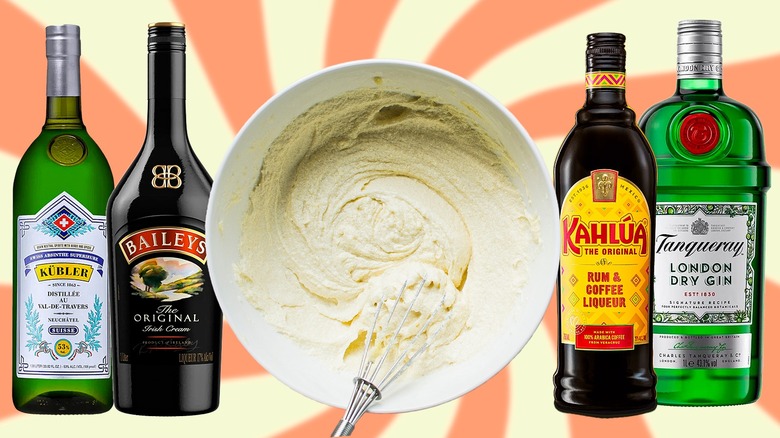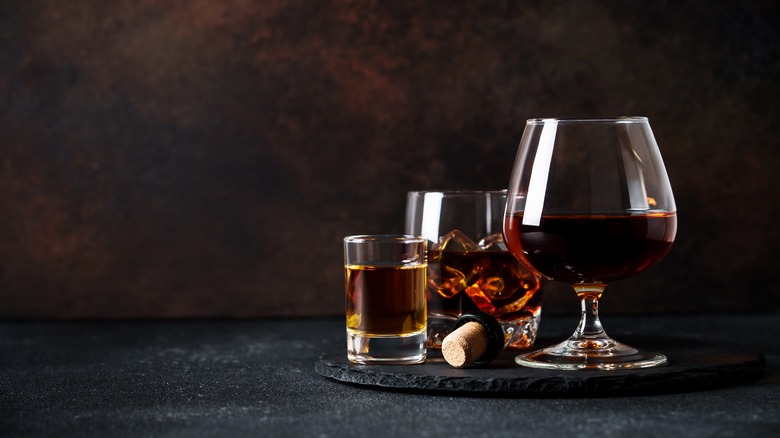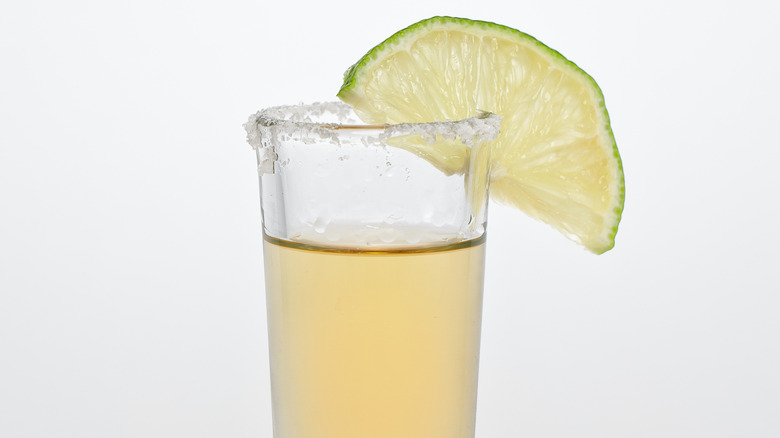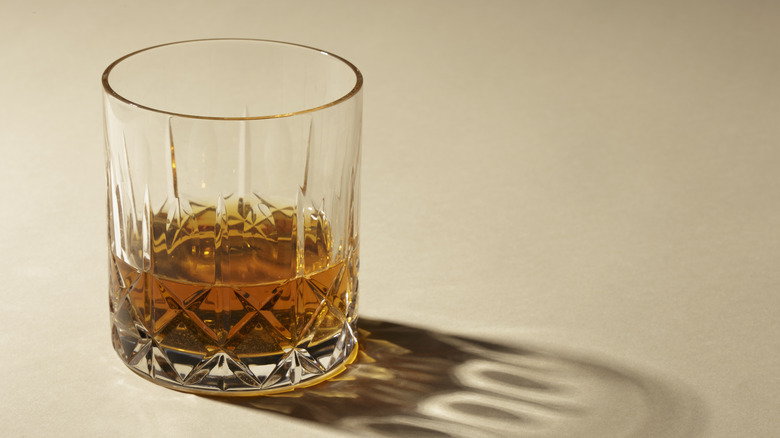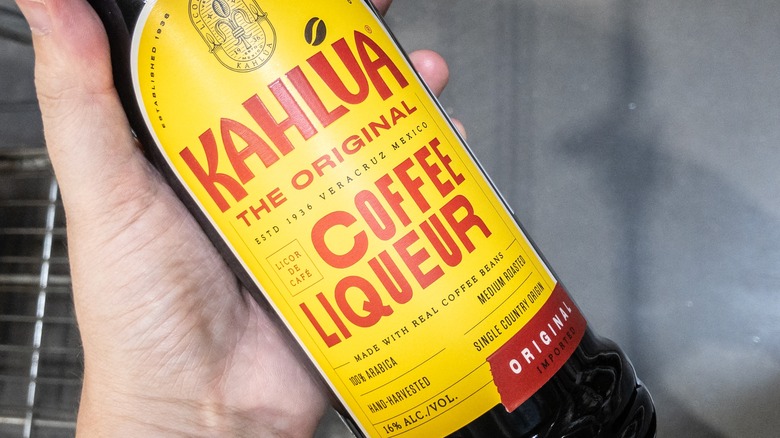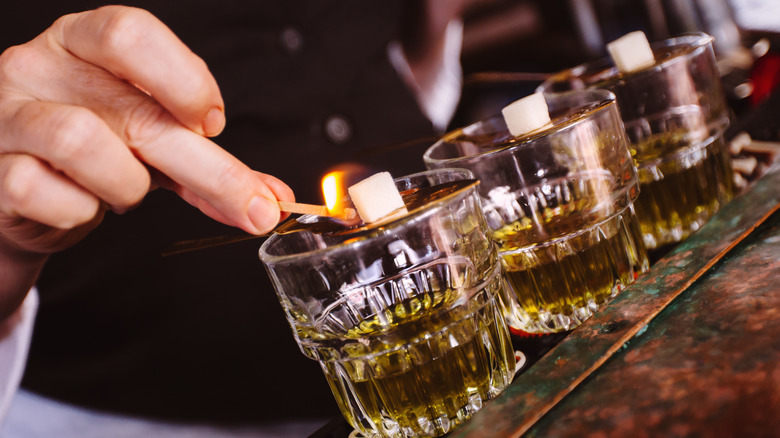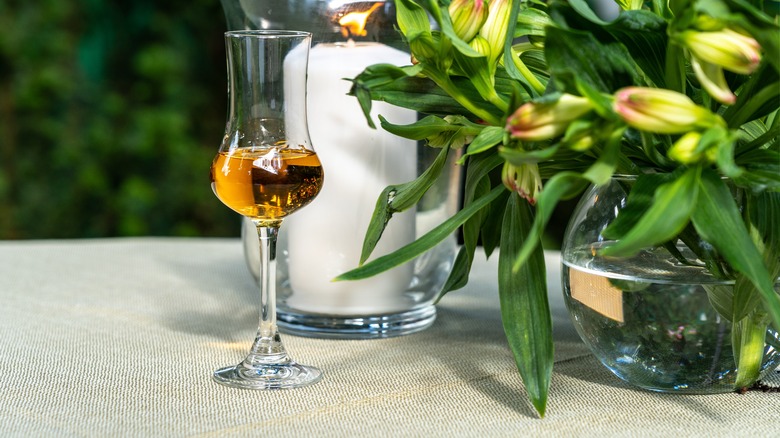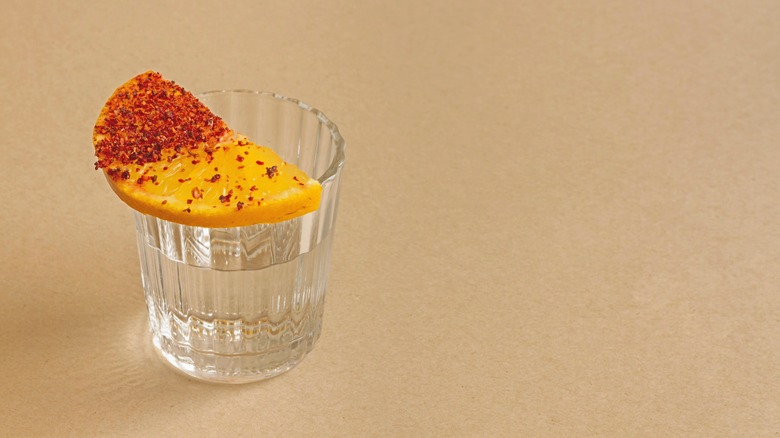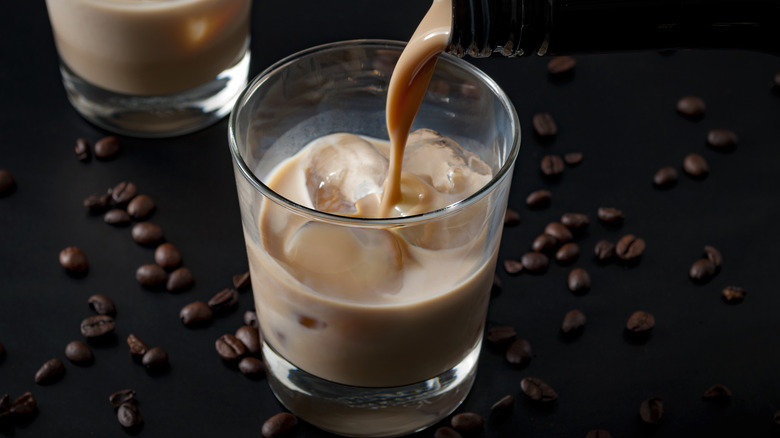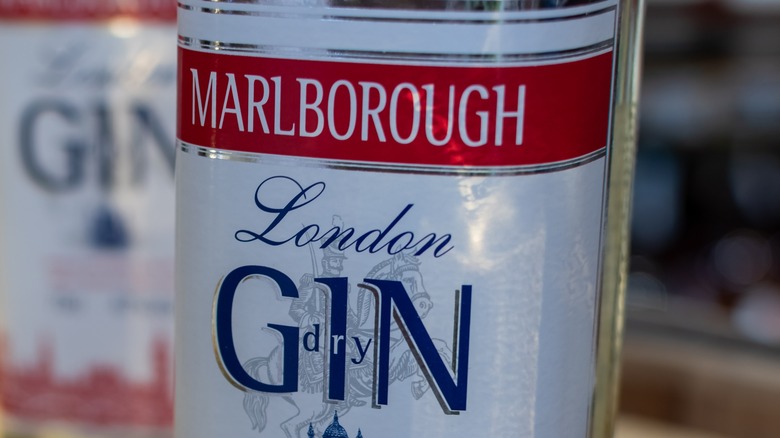6 Best Liquors To Add To Cake Mix And 6 To Avoid
Adding liquor to your baking isn't just about adding a boozy kick; it's a way to elevate your cake into a sophisticated dessert with depth, richness, and a unique layering of flavors. The right liquor can enhance sweetness, add warmth, or bring out subtler notes that extracts alone can't achieve. Think of dark rum's caramelized sugar, bourbon's boozy and smoky oakiness, or Irish cream's velvety sweetness — all distinct profiles that can make a cake truly unforgettable. But not every liquor will work; some spirits can clash with the cake's natural flavors, leaving a harsh aftertaste or affecting the cake's delicate texture.
As a professionally trained chef with a small-but-mighty pastry background, I've experimented with infusing a range of spirits in cakes, from dense chocolate pound cakes to airy citrus layers, and have learned through experience which liquors enhance and which detract. In this guide, I'll introduce you to my favorite liquors to add to cake mixes; those that bring moisture, complexity, and a refined flavor without overpowering. I'll also highlight the ones to skip; spirits that might leave your cake too bitter or medicinal, disrupting the balance of a well-baked treat. You know, the ones you're better off leaving out on the bar cart for your guest to drink — not eat.
Are you after a bold flavor or something more subtle in your dessert? These recommendations will help you select the perfect alcoholic addition for your cake, giving it a professional, lush touch that's sure to impress.
Add: dark rum
Dark rum is a baker's secret weapon, bringing a rich, caramelized sweetness that works wonders in cakes with chocolate, vanilla, and spice. Unlike lighter rums, dark rum has been aged longer, often in charred oak barrels, which gives it deep, molasses-like notes and an almost smoky richness. This aging process adds depth and warmth, making dark rum a perfect pairing for cakes that feature bold, warm flavors — think traditional rum cakes, spiced bundts, and chocolate pound cakes.
Add about 2-3 tablespoons of dark rum to the batter; this will infuse the cake with moisture while giving it a luscious, slightly caramelized flavor. Dark rum pairs beautifully with spices like cinnamon, nutmeg, and cloves, enhancing their aromas without overwhelming them. Consider using a dark rum glaze or syrup to brush onto the cake once it's baked and slightly cooled. This added touch boosts moisture, amplifies the rum's sweetness, and creates a glistening finish that's as delicious as it is eye-catching.
In chocolate-based cakes — and even in a recipe like spiced chocolate rum banana bread — dark rum adds a sophisticated, bittersweet note that balances the richness of the cocoa, making each bite taste indulgent and multi-dimensional. Its versatility also shines in cakes with nuts or tropical flavors like coconut, where it complements the cake's sweetness. With dark rum, each slice becomes a satisfying, memorable bite — rich, aromatic, and full of depth.
Avoid: tequila
Tequila, with its sharp, earthy notes and strong alcohol profile, is generally a poor choice for cake baking. While tequila can work beautifully in cocktails, its flavor profile often clashes with sugary, baked flavors, leaving a bitter aftertaste that detracts from the cake's sweetness. Its intense taste and herbal bite don't blend well with most cake ingredients, creating an unbalanced and sometimes unpleasant flavor combination.
In some cases, tequila can work in small doses within specific desserts, like margarita-inspired cupcakes with lime. But if you're looking for a spirit to bring out other citrus flavors, other options, like a light rum or a citrus liqueur, offer a gentler, more complementary flavor profile. This Mexican spirit's sharpness can also overpower more delicate cake flavors like vanilla or chocolate, resulting in a dessert that feels more like a cocktail than a treat. Additionally, tequila's high alcohol content can affect the texture of the cake, making it denser or even slightly gummy if overused.
Tequila's often bold taste and limited compatibility with traditional cake ingredients make it a challenging addition — and therefore, an avoidable choice if you want an enjoyable dessert. So, leave it out, and grab some triple sec and chili oil to make spicy margs instead.
Add: bourbon
Baking with bourbon adds a beautiful depth to cakes with its warm, complex profile, featuring notes of vanilla, caramel, and oak. Known for its sweetness balanced with subtle smokiness, bourbon especially complements cakes with earthy, rich flavors like chocolate, pecan, and apple, especially in desserts inspired by autumn. These flavor undertones, along with its woodsy, aged taste, make this liquor an excellent choice for cake recipes where you want to add something multifaceted and interesting.
When using bourbon, aim for about 2 tablespoons in the batter, or try brushing it on cake layers as they cool. This technique not only infuses the cake with flavor but also locks in moisture, creating a tender crumb that's irresistible. Bourbon's high notes pair well with brown sugar and caramel, enhancing spiced or nutty fillings in pecan or apple cakes. It's also a great match with cream cheese or buttercream frostings, where it adds a toasty, sweet counterpoint to the frosting's richness.
For apple-based cakes, bourbon's unique blend of caramel and oak flavors, in particular, intensifies the natural sugars in the fruit, making each bite feel like a cozy treat. In chocolate cakes, it introduces a subtlety that enhances the richness of the cocoa. Whether in a caramel apple cake, a chocolate bourbon bundt, or a classic pecan cake, bourbon's flavorful intricacies make it a go-to for creating a dessert with layers of flavor.
Avoid: vodka
While vodka may seem neutral, it doesn't bring much to a cake other than alcohol content, lacking the flavors needed to enhance or balance out a dessert. In cooking and some baking, vodka is typically used for its clean, flavorless profile — but for a dessert like a cake, this often means it adds no depth or interest to the final product.
Unlike brandy or rum, which bring warmth and richness, vodka contributes very little and will leave a cake tasting flat. In fact, vodka can sometimes leave a slightly harsh, boozy aftertaste, especially if added in large amounts, which detracts from the sweetness and subtlety of most cakes. If you're looking for a way to enhance flavors, spirits like bourbon or amaretto will have more layers without overwhelming the cake. Vodka may work well in pie crusts to help with flakiness, but it doesn't have any real flavor compatibility to justify its use in cake batter. For those hoping to add moisture or an extra dimension to their cake, consider using a liquor that complements the other ingredients, like Irish cream or coffee liqueur, which bring both flavor and moisture.
Vodka's translucence, while useful in some culinary applications, just doesn't serve well in most desserts. You can save your vodka for pasta sauce and drinking.
Add: coffee liqueur
Coffee liqueur, like Kahlúa, brings a rich, mocha-like depth to cakes, especially those featuring chocolate or coffee flavors. It's more than just a flavoring; coffee liqueur adds a subtle bitterness that brings out chocolate's notes and richness, and it ultimately offers a nice contrast to sweeter cake mixes.
With notes of roasted coffee beans and a touch of vanilla, this liqueur is especially ideal for tiramisu-inspired cakes, mocha brownies, or layered chocolate cakes where you want a hint of espresso without the acidity of brewed coffee. To get the best results, add about 2-3 tablespoons of coffee liqueur to your cake batter. This amount provides enough flavor to infuse each bite without overpowering the other ingredients. Coffee liqueur is also excellent in glazes or syrups that can be brushed over a baked cake for a polished, bakery-style finish. For chocolate-based desserts, coffee liqueur also creates a smooth contrast that intensifies chocolate notes, turning a simple cake into some decadent eating. Pair coffee liqueur with other complementary flavors like vanilla, caramel, or cinnamon.
If you want to take it to the next level, you might even pull an Ina Garten and make a Kahlúa mocha frosting. A mocha cake with a coffee liqueur-infused ganache or buttercream frosting can make an unforgettable dessert. Coffee liqueur also pairs wonderfully with cream cheese frostings, adding a hint of sophistication to your cake's finish. When used thoughtfully, this liqueur elevates the flavor profile of pretty much any sweet treat.
Avoid: absinthe
Absinthe, known for its strong anise flavor, is an acquired taste that rarely complements sweet desserts. Its licorice notes and underlying bitterness can easily disrupt the delicate balance of a cake, leaving an almost medicinal aftertaste. While absinthe's intensity works well in certain cocktails, it will clash with ingredients like chocolate, vanilla, or fruit, resulting in a dish that tastes strikingly discordant.
Adding absinthe to a cake batter also risks a potential textural change. This liquor's high alcohol content can alter the cake's structure, leading to a denser or overly moist crumb if not used carefully. For most cakes, then, absinthe is simply too much, and it can transform a sweet dessert into an oddly savory bite. Its bold, herbal characteristics are instead better suited to savory dishes or cocktails rather than sweet, delicate cakes. That said, if you're hoping to add a hint of licorice flavor to a cake, consider using a smaller amount of anise extract or fennel seeds for a gentler effect. All in all, it's best to skip absinthe for baking and save it for dropping flaming sugar cubes in.
Add: amaretto
Amaretto, an almond-flavored liqueur, adds a sweetness that complements a range of cake flavors. Its distinct, slightly bitter nutty taste creates a lovely contrast in cakes featuring fruit — it pairs beautifully with cakes that feature cherries, oranges, or even cranberries — as well as chocolate or spices, adding a refined touch without doing too much on the palate. So, whether you're working with a pound cake, a fruit-based sponge, or a simple vanilla layer cake, amaretto offers a unique depth and a hint of sophistication that can make any dessert special.
For the best flavor, add about 2 tablespoons of amaretto to your cake batter. This small amount goes a long way. Amaretto is particularly delightful in cakes with almond flour or ground nuts, as it accentuates that nut-like flavor, making each bite taste harmonious and rich. Pair it with a hint of citrus zest or fresh berries for a fresh contrast that's both balanced and bold. But for an extra layer of flavor, try adding amaretto to a glaze or syrup that can be brushed onto the cake post-bake. This technique adds moisture and creates a lightly sweet crust that enhances the almond flavor.
Amaretto's versatility and subtle sweetness make it an exceptional choice for cakes where you want an aromatic touch without overshadowing the other ingredients. This liqueur will turn an everyday dessert into something truly memorable.
Avoid: mezcal
Mezcal's intensely smoky flavor is one of its defining characteristics, but it can be a bit much for baking a cake. Known for its rich, earthiness and hints of spice, mezcal often shuts out the delicate sweetness and nuances in a cake, leaving an imbalance that weighs the cake down by the spirit's unique taste. So, while it works wonderfully in savory dishes or cocktails, mezcal's flavor profile is simply too much for a cake.
Adding mezcal to a cake batter can introduce a bitter, acrid note that doesn't blend well with common flavors like chocolate, vanilla, or citrus. It can also affect the cake's texture if not used sparingly, creating a denser crumb or an off-putting aftertaste. Indeed, it can easily turn a decadent dessert into something that feels too experimental, detracting from the cake's intended sweet flavor and subtlety. However, if you're drawn to mezcal's smokiness, consider adding a small amount to the frosting or glaze rather than the cake itself to keep its bold flavor from taking over the dessert. Choosing a spirit with a gentler profile, like brandy or bourbon, will give you better results. Save the mezcal for smoky negronis and mole negro.
Add: Irish cream
Irish cream brings a creamy, chocolate-coffee flavor to cakes, making it an ideal addition for desserts that need an extra layer of richness. With its smooth, velvety texture, it blends easily into batters and frostings, infusing them with a balanced sweetness that's subtle yet distinctly indulgent.
This cream liqueur is particularly well-suited to chocolate cakes, cheesecakes, or even coffee-flavored cakes, where it complements rather than competes with other flavors. To incorporate Irish cream into your cake, add 2-3 tablespoons to the batter, which will add moisture and subtle coffee-cocoa notes without altering the cake's structure. Irish cream can also be used in glazes or whipped into a buttercream frosting, creating a harmonious, rich finish that pairs beautifully with the cake itself. In chocolate cakes, it really enriches the depth of cocoa. So, a chocolate cake with Irish cream in both the batter and frosting can feel like a dessert that's straight out of a high-end bakery.
For a sophisticated twist, pair this liqueur with flavors like vanilla, cinnamon, or even caramel, which amplify its creamy sweet flavor and even out its mild, boozy bite. Irish cream is an excellent choice for those looking to add a touch of elegance and depth to their cakes without overwhelming the palate.
Avoid: peppermint schnapps
Peppermint schnapps has an unmistakably intense mint flavor that, while good in cocktails, can cover up a cake's subtle sweetness and mask the other ingredients. Instead of adding complexity, then, peppermint schnapps often makes everything one dimensional, resulting in a dessert that just tastes overly sharp and almost cloying.
When added to batter, this spirit can also interfere with the cake's moisture balance, creating a slightly tacky texture if overused. Its strong alcohol content also means it's easy to add too much. In chocolate cakes or holiday-themed desserts, peppermint flavoring can work well in moderation, but peppermint schnapps is typically too harsh for a balanced dessert. So, if you're hoping for a hint of mint, consider adding peppermint extract or even fresh mint leaves in a controlled amount instead. Peppermint schnapps' tendency to dominate other flavors makes it better suited for drinks than for cakes. Eggnog, anyone?
Add: brandy
Brandy is a classic choice for adding warmth and depth to cakes, especially those featuring fruit or spices. Known for its smooth, subtly sweet flavor with hints of oak and dried fruit, this spirit enhances the natural sugars in these ingredients. It's particularly well-suited to autumn and winter desserts, lending a cozy sophistication that pairs beautifully with flavors like apple, pear, cinnamon, and nutmeg.
To incorporate brandy into a cake, add about 2-3 tablespoons to the batter. For a traditional fruitcake or spice cake, consider soaking dried fruits in this liquor beforehand to bring a boozy moistness to the crumb. You can also brush brandy onto the cake after baking for an added layer of flavor and moisture. For an even more memorable touch, use brandy in a glaze or drizzle it lightly over the cake to bring out its flavors, creating a dessert that's both elegant and satisfying. This spirit also works wonderfully in cakes that include nuts or caramel. Pair it with buttercream frosting or whipped cream for a refined dessert that's both indulgent and nicely balanced. Brandy's slightly aged flavor can elevate any cake, making it taste like a handcrafted treat.
Avoid: gin
Gin is often the life of the party in a cocktail, but when it comes to adding spirits to a cake mix, gin's distinctive profile makes it a difficult match. The botanical and herbal flavor that gives gin its character is usually built from ingredients like juniper berries, coriander, citrus peels, and other earthy spices. While these flavors work great in a gin and tonic or a martini, they're less compatible with the sweet and buttery base of cake batter.
One of the main issues with gin in cakes is its strong, piney aroma. The juniper in gin, which is usually front and center, can be surprising (in a bad way) in a baked dessert, especially as its aromatic oils intensify during the cook. Instead of complementing the flavor profile, gin tends to overpower it, resulting in an aftertaste that might not appeal to many dessert lovers. Moreover, gin lacks the caramel or vanilla undertones found in spirits like rum or whiskey, which blend seamlessly into cakes. Since these flavors are common in dessert recipes, their presence enlivens the richness of baked goods. Gin's flavor profile is more complex and layered in ways that are generally better suited to savory pairings or herb-infused recipes, not cakes.
